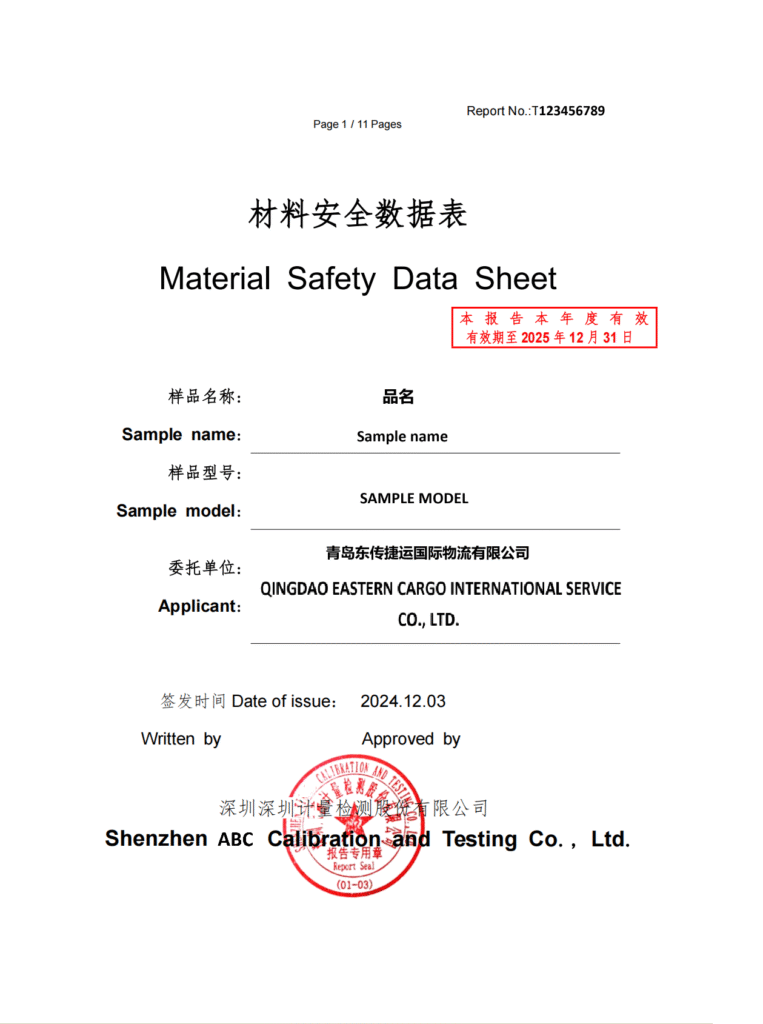17 Essential Elements Checklist for MSDS (Material Safety Data Sheet) | 2024 Latest Standards
 MSDS (Material Safety Data Sheet) serves as the core safety document for chemical transportation, storage, and usage. According to GHS (Globally Harmonized System of Classification and Labelling of Chemicals) and OSHA Hazard Communication Standard (29 CFR 1910.1200), a compliant MSDS must contain 17 standard elements. This article provides a complete verification checklist and details the key requirements for each section.
MSDS (Material Safety Data Sheet) serves as the core safety document for chemical transportation, storage, and usage. According to GHS (Globally Harmonized System of Classification and Labelling of Chemicals) and OSHA Hazard Communication Standard (29 CFR 1910.1200), a compliant MSDS must contain 17 standard elements. This article provides a complete verification checklist and details the key requirements for each section.
1. Identification
✅ Must include:
Product name (e.g., Sulfuric Acid, 98%)
UN number (e.g., UN1830)
Supplier information (company name, address, emergency contact number)
Recommended use and restrictions
📌 Verification points:
Does it include a 24-hour emergency contact number?
Is the UN number consistent with IMDG Code?
🔗 MSDS Database (External Link): ChemicalBook MSDS Database
2. Hazard Identification
✅ Must include:
GHS pictograms (e.g., corrosive, flammable)
Signal words (“Danger” or “Warning”)
Hazard statements (H-Phrases, e.g., H290: May be corrosive to metals)
Precautionary statements (P-Phrases)
📌 Verification points:
Does it cover all relevant hazard classes?
Is it consistent with transport labels?
3. Composition/Information on Ingredients
✅ Must include:
Chemical composition (e.g., Sulfuric Acid ≥98%)
CAS number (e.g., 7664-93-9)
Impurities or stabilizers (e.g., ≤0.1% heavy metals)
📌 Verification points:
Are all hazardous ingredients (≥1% concentration) listed?
Are confidential ingredients marked as “Trade Secret”?
4. First-Aid Measures
✅ Must include:
Emergency procedures for different exposure routes (inhalation, skin contact, eye contact, ingestion)
Need for medical intervention (e.g., seek immediate medical attention)
📌 Verification points:
Does it provide specific first-aid instructions (e.g., “Rinse with plenty of water for 15 minutes”)?
✉ Emergency Consultation (Internal Link): Contact Eastern Cargo Experts
5. Fire-Fighting Measures
✅ Must include:
Suitable extinguishing media (e.g., CO₂, dry chemical)
Hazardous combustion products (e.g., sulfur dioxide)
Protective equipment for firefighters (e.g., positive pressure SCBA)
📌 Verification points:
Does it indicate whether the chemical is combustible?
6. Accidental Release Measures
✅ Must include:
Personal precautions (e.g., chemical-resistant gloves, goggles)
Environmental precautions (prevent entry into drains)
Cleanup methods (e.g., use inert absorbent material)
📌 Verification points:
Are there different response plans based on spill size?
7. Handling and Storage
✅ Must include:
Handling conditions (ventilation, static electricity prevention)
Storage incompatibilities (e.g., “Keep away from oxidizers”)
Packaging material compatibility (e.g., polyethylene containers)
📌 Verification points:
Are temperature sensitivity requirements specified (e.g., “Store below 30°C”)?
8. Exposure Controls/Personal Protection
✅ Must include:
Occupational exposure limits (e.g., TLV, PEL)
Engineering controls (local exhaust ventilation)
PPE requirements (glove type, respirator specifications)
📌 Verification points:
Are the latest OEL standards referenced (e.g., ACGIH 2024)?
9. Physical and Chemical Properties
✅ Must include:
Appearance, odor, pH
Boiling/melting point, flash point, explosive limits
Density, solubility
📌 Verification points:
Are all critical data complete (e.g., flash point affects transport classification)?
10. Stability and Reactivity
✅ Must include:
Conditions to avoid (light, heat)
Incompatible materials (e.g., strong oxidizers)
Hazardous reactions (polymerization, decomposition products)
📌 Verification points:
Are all known incompatible materials listed?
11. Toxicological Information
✅ Must include:
Acute/chronic toxicity (LD50, LC50)
Carcinogenicity (IARC classification)
Target organ effects (e.g., liver damage)
📌 Verification points:
Are authoritative studies referenced (e.g., EPA, EFSA)?
🔗 Toxicity Data Query (External Link): ChemicalBook Toxicity Database
12. Ecological Information
✅ Must include:
Biodegradability
Aquatic toxicity (fish LC50)
Marine pollutant status
📌 Verification points:
Is “Persistence, Bioaccumulation and Toxicity” (PBT) indicated?
13. Disposal Considerations
✅ Must include:
Waste packaging handling (e.g., thorough cleaning)
Contaminated absorbents to be treated as hazardous waste
📌 Verification points:
Does it comply with local regulations (e.g., China’s Solid Waste Law)?
14. Transport Information
✅ Must include:
UN number, proper shipping name
Packing group (I/II/III)
Special sea/air transport requirements
📌 Verification points:
Is it consistent with IMDG/IATA regulations?
✉ Transport Compliance Consultation (Internal Link): Contact Eastern Cargo Logistics Experts
15. Regulatory Information
✅ Must include:
National regulations (e.g., China’s Catalog of Hazardous Chemicals)
International regulations (REACH, TSCA)
📌 Verification points:
Is it updated to the latest version?
16. Other Information
✅ Must include:
Revision date
Abbreviation explanations
Disclaimer
📌 Verification points:
Does it state “This MSDS applies only to the current product”?
MSDS Verification Tools & Resources
Online Verification (External Link): ChemicalBook MSDS Database
Template Download (External Link): OSHA MSDS Format Guidelines
Professional Support (Internal Link): Request Custom MSDS Review Services